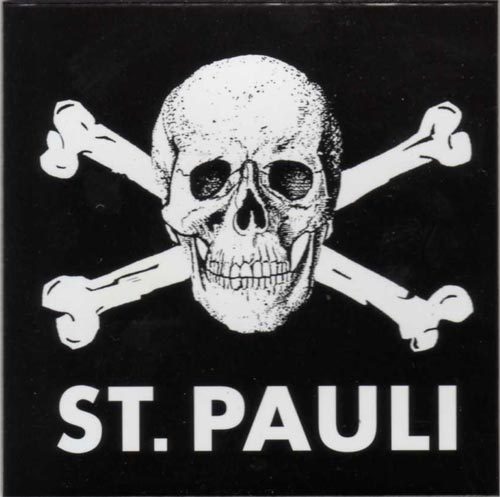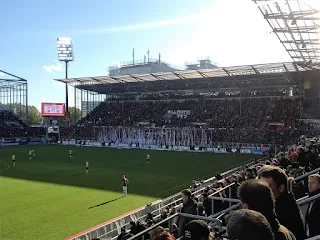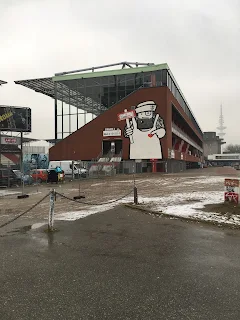FC St Pauli is
a football club based in the St Pauli district of Hamburg in Germany. The
football club is part of the St Pauli sports club, which also has sections for
rugby, baseball, bowling, boxing, chess, cycling, handball, roller derby, skittles,
softball and table tennis.
The club was
formed on the 15th May 1910, beginning life as St Pauli TV, playing in local
regional football and playing matches at Heiligengeistfeld, which is next to
the current home stadium. In 1924, the present title was taken up, with the team still competing regionally, winning an occasional promotion and suffering relegations.
In 1946, the club built its
own stadium in the corner between Glacischaussee and Budapester Strasse. St Pauli
reached the semi-finals of the national rounds in 1947-48 before losing to 1FC
Nuremberg while members of Oberliga-Nord. In 1961, construction on a new home
ground, Millerntor-Stadion, began.
In 1963 saw the re-organisation of
German football with the formation of the professional national Bundesliga. St Pauli found themselves in the second-tier Regionalliga Nord. The club suffered disappointments in 1963-64 and 1965-66 when finishing as champions but then missing out on promotion through the play-off groups.
It was a
similar story in 1970-71 after ending as Regionalliga Nord runners-up before
winning the title in 1971-72 and 1972-73, as well as runners-up in 1973-74. The
play-off groups continued to be one step too far. The 2.
Bundesliga was formed in 1974, with St Pauli becoming an inaugural member.
In 1976-77, the team finally reached the top flight after the goals of Franz Gerber helped the side to the Nord title, although their spell lasted just one
season. Worse was to follow as the club were close to bankruptcy and denied a
license, meaning relegation down to Oberliga Nord. In 1983-84 St Pauli had recovered sufficiently to win a place in 2. Bundesliga.
In the mid-80s, Freibeuter der Liga (Buccaneers of the League) had begun to appeal to
fans as a 'Kult Club', using its base near the docks and the famous
Reeperbahn nightlife location to attract fans, as the decade started with
crowds of around 1,600 at Millerntor. Left-wing
politics and anti fascism with punk music were preferred by fans as the scull
and crossbones flag was adopted.
This fitted in well with the population of the
surrounding area, as support rapidly grew. The team were relegated back to the Oberliga in 1984-85, but went straight back up at the end of the following campaign. By 1987-88, they were back in the Bundesliga for three years, before going back down to the second tier at the end of the 1989-90 campaign.
A further
top-flight spell was played out between 1995 and 1997. Work on Millerntor
commenced to deal with the increased demands, and the side responded with
another single-season spell in the Bundesliga for the 2001-02 season, where the
TV money was squandered on underperforming players.
Another relegation and financial crisis in 2003 led to much-needed fundraising and a benefit game against Bayern Munich. The fans introduced charity initiatives to children in poorer countries, while continuing to create a party atmosphere on matchdays.
The team
reached the DFB Pokal semi-final in 2006, before Bayern Munich
ended any dreams of silverware. Promotion back to the 2. Bundesliga was achieved in
2006-07, with St Pauli winning promotion to the Bundesliga at the end of the
2009-10 season under chief trainer Holger Stanislawski.
During the 2010-11 season, St Pauli beat local rivals SV Hamburg in their away match with a Gerald Asamoah goal, but it was to end in vain as the team were once again relegated at the end of the campaign. Stanislawski was replaced by André Schubert, who led the team to a fourth-place finish.
André
Schubert, Michael Frontzeck, Roland Vrabec and Thomas Meggle all had time at
the helm at Millerntor as the team finished in mid-table. The arrival
of Ewald Lienen in December 2014 saw an improvement in the team's performances as
he guided St Pauli away from relegation worries and to fourth and seventh-place
finishes.
Lienen moved
upstairs as technical director in the summer of 2017, with Olaf Janßen arriving
as the new chief trainer before being replaced by Markus Kauczinski at the winter break. 2018-19
saw St Pauli end in ninth as Jos Luhukay arrived as trainer before the season's end. Dimitrios Diamantakos led the team scoring chart the following season.
Timo Schultz became team boss during the 2020-21 campaign, taking them to fifth place the following season, with Guido Burgstaller rattling in the goals. Fabian Hürzeler arrived as chief trainer in 2022-23 as St Pauli again finished fifth. The goals of Marcel Hartel fired the side to the 2. Bundesliga title in 2023-24 and promotion back to the top flight.

Hürzeler headed off to take the Brighton & Hove Albion job, to be replaced by Alexander Blessin, whose side consolidated their position.
FC St Pauli will play in the Bundesliga in the 2025-26 season.
My visit
FC St Pauli 3 Dynamo Dresden 2 (Sunday 28th October 2012) 2 Bundesliga (att: 21,045)
I was in Hamburg on day three of four of a solo adventure around Germany, taking in as much football and socialising as possible. My morning had begun in Düsseldorf, before taking an early train north. During my stay, I had already been to see games in Cologne and Gelsenkirchen, and then a local game in Hamburg at US Paloma on arrival that morning.
I realised that tickets at Millerntor-Stadion were hard to come by, but by using the foreign fans' email service on the club website, I had managed to obtain a seat for €50. This seemed rather expensive for second division football, but I was advised on the forum I use for groundhopping that it was as good as I would get.
I simply had to turn up with my reservation email and pay on the day, which I thought was very trusting. I left my morning game, which had been played a few miles north, early, as I wanted to ensure my ticket was still there and they didn't sell it, as the match was in high demand.
I got off the U3 train at St Pauli station and was met at the top of the stairs by the beginning of the construction of the Hamburg Dom funfair on the large Heiligengeistfeld, meaning dodging around caravans and steelwork. Near Millerntor, the scene was confused, not helped as the Back Straight stand was in a state of semi-completion.
The building of the stand explained which tickets were in demand, with capacity being down. Lots of fans held up signs which appealed for the purchase of a match ticket. My advance purchase was definitely necessary. I found the ticket office at the rear of the South Stand after assistance from a steward.
The gent behind the counter was helpful and friendly, and I was soon on my way. I bought a scarf for a pal back home, Andy Crossland, and then attempted to find my way in. To be honest, the arrangements were a bit of a shambles, but eventually I found the correct gate, and after a quick search, I was inside thirty minutes before the 1.30 kick-off
The concourse had art galleries along the walls. Some concessions sold fish in bread, which related to local culinary choices. I was pleased to see that the club hadn't adopted the stadium card system and that I was able to purchase from the outlets with cold, hard cash. I bought a sausage, which came with a small piece of bread and a Holsten beer.
I was eager to locate my seat, but I was most concerned that I couldn't find the corresponding entrance. I went up the stairs and in and asked another steward. I had to walk along the front and then up to the leather business seats. Happy with my location, I went for a refill before the teams came out.

My seat was at the end of the middle third, nearest to the extremely feisty eastern away fans. Millerntor was creating an incredible atmosphere. I was in the Main Tribune. This was a raised single tier of seating with a raised level of lounge seats at the rear for corporate clients.
This stand joined up with an area of corporate boxes, offices and the changing rooms to my right, with the South Stand, which had standing at the front and then seating and more exclusive seating and boxes. Opposite the Back Straight only had a reduced capacity in the large terracing at the front, with portable TV gantries restricting the number of fans.

The seating deck at the rear and the roof were still awaiting completion. Finally, to the left was the North Stand. This was the oldest construction at the stadium, even though it looked semi-temporary on its scaffolding frames. There was standing room at the front and seats at the rear. The away section contained 2,155 Dresdeners.
The home fans, predominantly in the South Stand terracing, played with rainbow balloons to show their portrayed tolerance to all and flew banners while making a real noise, to which the Dynamo fans reacted with their Capos at the front orchestrating them. The teams emerged to the sound of ACDC's Hell's Bells booming out over the PAs.
Kick off was delayed as the linesman and several stewards attempted to disentangle all the streamers and toilet rolls that had been thrown on from the home fans in the South Stand. I was sitting next to a most helpful gent with a good command of English, who was keen to chat once he'd heard of my exploits.
We were both a little taken aback as all hell was being let loose in the away section. Dresden fans were trying to scale the fences and looking for a real go with the police, while a gate at the front was kicked open. It transpired that a banner had been taken from the fencing and confiscated.
I was looking for places to scarper to, as I wondered if the Dresden fans would be looking to have a go. It was as fierce an atmosphere as I'd been in since the 80s back home in England, and I must admit, it was exhilarating. It was everything that modern football wasn't. Eventually, someone with half a brain decided to throw the banner back.
This was met with applause and a complete change in temperature. The fans got right behind their team instead. Dynamo went one up as their fine flying French winger, Idir Ouali, finished off a fine move past the rather static St Pauli defence. It was two after twenty-eight minutes after Mickael Pote scored unmarked, as once again the home team looked as though they'd been out the night before in the nearby Reeperbahn.
The home fans were not particularly amused, but gradually their team awoke. Fabian Boll turned and fired home to reduce the deficit a minute before the break. I had a
wander about before returning to my comfy seat and enjoying a fine fight back
from the self-proclaimed 'Die Freibeuter der Liga', meaning Buccaneers of the
League.
Christopher Avevor headed St Pauli level from a corner within four
minutes of the re-start, and then seven minutes later, a lovely Boll pass set the
good run from Daniel Ginczek through to finish to complete the turnaround, and
delight the coach Michael Frontzeck.
After that, the home side saw out the game with relative ease. I said my goodbye and exited near the players' tunnel. I had a laugh at a sign under the stand under the
club crest, which read, 'Non-Established Since 1910'. All day, I hardly saw any
fans under sixteen. It really was a place for the sixteen-to-fifty age group.
I had been
told of a football pub to try, in the hope of catching the end of the
Merseyside derby, but could only see the Jolly Roger fan pub, where
celebrations were in full swing. I headed down some side streets to try and
find a bar showing the game, but settled on popping inside Ginst on Paul-Roosen-Straße.
I settled
with a bottle of Astra local beer and asked if I was OK to sit at a table where
one bloke was perched, who I thought had been to the game. The conversation wasn't going too far, but I
didn't think I'd done anything too wrong when he started muttering expletives.
Some more men came in and joined us. I tried to be polite as ever, and in time, I was accepted. I popped outside to see a cavalcade of police vehicles that I'd not seen after a match in years in the UK. I said my
goodbyes on good terms after another bottle, having been told that migrants
from the east were a major problem in the city regarding jobs and financial
earnings.
I found myself on the Reeperbahn to catch the train back
to the Hauptbahnhof to pick up my bag and book into the Hotel
Lumen am Hauptbahnhof for a siesta. I headed out for the evening after resting and
got off near the town hall, but found the town to be quiet, so I had a walk and
then a train ride. I walked up the Reeperbahn.
Now I'm a well-travelled man and pretty broad-minded at that, but I found it too full on. I was physically grabbed, which I neither like nor trust, by the ladies, who were
obviously not looking to discuss Kevin Keegan's spell at the Volkspark or Georg
Albertz's time at Ibrox. I walked round the corner to Budapester Strasse and past
Millerntor to the Jolly Roger.
I decided to give it a punt and initially I was
really impressed by the buzz of the place and the superb music being played by
Chrischian and his Alcoholic Nightmare night. At that
point, I was obviously being spoken about as I wasn't in filthy jeans or t-shirts
with a scull and crossbones or declaring that I demanded a class war.
I think it was suspected that I was some kind of infiltrator. I was maybe trying too
hard to mix in. As soon as I spoke in English with someone, I was accepted, by
some anyway. I wasn't going to shift. After all, this was meant to be the fans
who lauded tolerance? Maybe just if you agreed with them?
Chrischian
knew his place and stopped playing when brief highlights of the afternoon game
were shown on the TV. There were stickers all over the walls as well as mementoes from other clubs from around the world, mainly Celtic. It wasn't
unlike the old Tunnel Club in Scarborough. It wasn't a football club, it was a
style of life.
I ended the evening chatting to two Borussia Mönchengladbach fans who lived locally and had just returned from seeing their side come from two down to win three two at Hanover. I walked
back to the underground and passed an old boy on his bike who seemed to be
celebrating the afternoon win, judging by his riding inabilities.
The
following day, I returned to buy Carl Ellis a shirt at the club shop. The corner
of the ground by the Back Straight was open, so I got some better photos. I was
amazed at the prices in the shop, which was like a punk boutique complete with a dog wandering about and an assistant looking like a member of the Red Hot Chilli
Peppers.
A playing
shirt was €60. So much for the club of the working class! I wandered away,
still largely unconvinced, putting it down to an age thing.
Tuesday 31st January 2017
It was the
final day of a week-long tour that had taken me from County Durham, Yorkshire
and various German destinations in a feast of sightseeing, football, beer,
travel and thorough enjoyment, and I had a couple of hours to kill before my
flight home.
The cost of
flights from Hamburg was far better than from Hanover, where I’d stayed the
previous evening. The weather was extremely cold, with snow standing in open
areas. I took the U3 train to St Pauli.
The road and
park leading up to Millerntor were dicey underfoot owing to the inclement
weather. I reached my destination, but sadly, I couldn’t see an open gate.
Construction was now complete.
Not only had
the stand been completed that was in mid-use during my previous visit, but
another new stand had gone up at the away end. This appeared similar to behind
the other goal. It really did look like a fine stadium. As a
consolation, I wandered all the way around and managed to take some decent
exterior shots.
The graffiti announced that St Pauli were still the trendy club
in town, despite selling out to commercialism like any other progressive
organisation. I headed across to Feldstraße station and took the subway to Habichtstraße, from where it was a couple of hundred yards to the final club visit of the tour; HSV Barmbek-Uhlenhorst.



























No comments:
Post a Comment